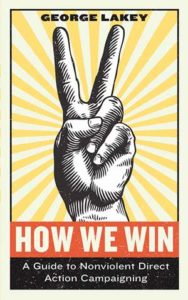How We Win: A Guide to Nonviolent Direct Action Campaigning
Reviewed by Steve Chase
November 1, 2018
 By George Lakey. Melville House, 2018. 224 pages. $16.99/paperback; $13.99/eBook (title available December 2018).
By George Lakey. Melville House, 2018. 224 pages. $16.99/paperback; $13.99/eBook (title available December 2018).
Buy from QuakerBooks
In June 1934 Quaker biblical scholar Henry Cadbury gave a keynote address to the Central Conference of American Rabbis. In his talk, Cadbury encouraged the assembled rabbis to show nothing but “good will” toward the Nazis and refuse to “fight back” in any way. Cadbury said that Jews and their allies should restrict themselves to engaging the Nazis in respectful dialogue and making verbal appeals to their “German sense of justice and the German national conscience.”
You might expect that the rabbis responded by angrily defending military efforts to put an end to the Nazi regime, but they didn’t. They objected instead to Cadbury’s rejection of all forms of nonviolent resistance, including organizing boycotts to weaken the Nazi regime. They objected to his saying that the power-wielding, nonviolent resistance campaigns used by Gandhi in the struggle to end British imperialism in India were “simply war without bloodshed” and should be avoided by all adherents of the Judeo-Christian tradition. The conference attenders even adopted a resolution rejecting Cadbury’s advice.
As a teenage Quaker in the late 1960s and early 1970s, I came to the same conclusion as these good rabbis. Borrowing books from my little Midwestern meeting’s library, I read the justice-loving prophets of the Bible, the nonviolent resistance writings of Gandhi and King, and several histories of Quaker nonviolent resistance to social evil from the “Lamb’s War” of the mid-1600s to campaigns of the present day. In the process, I stumbled upon George Lakey’s A Manifesto for Nonviolent Revolution. This Quaker activist made so much sense! Since then, I have read every book written by Lakey, including his recent How We Win: A Guide to Nonviolent Direct Action Campaigning.
How We Win is a practical manual for activists and essential reading for anyone who seeks to contribute meaningfully to social movements. I particularly recommend the book to all Quakers who are open to exploring nonviolent resistance as radical faithfulness in action—which even Cadbury did in his later years.
Lakey does not overplay the capacity of large, legal nonviolent protests to create change. He has learned that, by themselves, such marches and rallies are not how we win. As Lakey notes, “when I look back on the one-off protests I’ve joined over the years, I don’t remember a single one that changed the policy we were protesting.” He argues instead that to make protests like the Women’s March or the March for Our Lives more powerful, they need to be events within longer-term “nonviolent direct action campaigns.”
What Lakey means by “campaigns” is sustained, grassroots, collective efforts by ordinary people over time. Campaigns should adapt what Gandhi called “civil resistance” tactics into a strategic and escalating trajectory. Indeed, Lakey suggests moving well beyond simple protests into campaigns that include disruptive interventions like the lunch counter sit-ins of the 1960s civil rights activists as well as acts of mass noncooperation like labor strikes, tax refusal, or consumer boycotts.
While Lakey believes that electoral campaigning, lobbying, and litigation can be useful, he argues that nonviolent resistance campaigns are needed to build enough popular power to win needed reforms in the public interest.
The bad news, of course, is that organizing nonviolent direct action campaigns is difficult and sometimes risky work. Campaigns take time; often face repression; and require a steep learning curve to gain the knowledge, wisdom, and skill needed to be successful. The good news is that nonviolent resistance campaigns can be empowering (fun even), and frequently prove to be effective. In How We Win, Lakey weaves in hundreds of examples and stories of the ways campaigns around the world have won significant victories “addressing racism, sexism, and other systematic oppressions, environmental crises, violence, dictatorship and authoritarian abuses, and more.”
Lakey draws on his own extensive experience, his nonviolent action training workshops, and his decades-long study of nonviolent resistance movements—including his work with students at Swarthmore College researching and compiling over 1,000 campaign case studies in their online Global Nonviolent Action Database.
How We Win is written in a clear, conversational, and inviting style. Lakey covers important topics such as selecting issues, analyzing power dynamics and the social pillars of support for power holders, nurturing organizations, developing leadership, training participants, strategy and tactics to strengthen the campaign and weaken the campaign’s target, dealing with attacks and repression, building diverse coalitions, and encouraging bold visions. Lakey also offers a wide variety of strategy tools here, three interviews with comrades from Earth Quaker Action Team, and a solid resource section at the end.
As Lakey says, “This book describes the best practices I know for how people can work together to make a difference.” Reading it will be well worth your time. Applying its insights is even more useful.



Comments on Friendsjournal.org may be used in the Forum of the print magazine and may be edited for length and clarity.